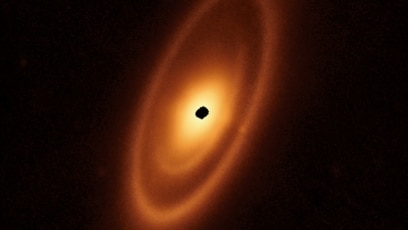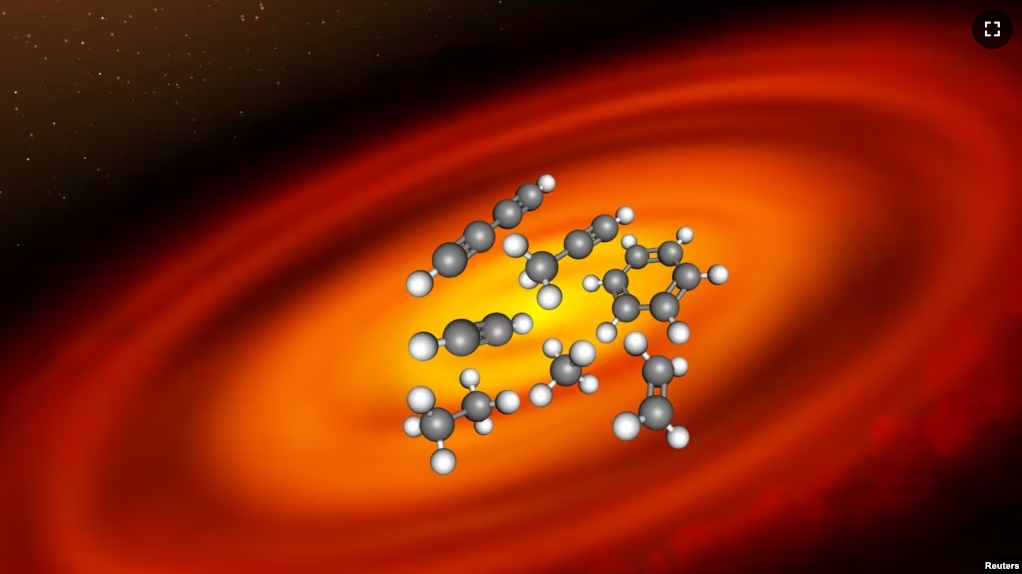Stars about the size of our sun are not the most common ones in the Milky Way Galaxy. Much smaller stars are far more common. Of all the stars in our galaxy, these small stars host the most planets. Scientists are studying the planets of these small stars in the search for worlds that may support life.
New research is providing understanding about how planets form around these small stars, called very low mass stars, or VLMS. The chemistry of the planet-forming disks of gas and dust surrounding them is different from similar disks observed around stars like the sun.
The James Webb Space Telescope has gathered data on a planet-forming, or protoplanetary, disk around a newborn star called ISO-Chal 147. It is only about 11 percent of the sun’s mass. Its diameter is about 43 percent of the sun’s, and its luminosity is about two percent of the sun’s. Luminosity is a measure of electromagnetic radiation.
ISO-Chal 147 is about 625 light years from Earth. A light year, the distance light travels in a year, is 9.5 trillion kilometers.
Webb’s observations showed that the gas in this star’s protoplanetary disk is rich in carbon with no evidence of water. This differs from new sun-like stars, which have oxygen-rich gas and a lot of water vapor in their disks.
Scientists wonder if this difference could influence the future habitability of rocky planets that form around these small stars.
“A planet mainly requires, among other things, water to be in liquid state and have a suitable atmosphere for it to be habitable,” said astrophysicist Aditya Arabhavi of the University of Groningen in the Netherlands who was lead writer of the study published recently in Science.
“Although we can expect that the different environment of VLMS disks would have a strong influence on the planetary composition and thus the habitability, it is difficult to predict whether this makes it less likely to be habitable,” Arabhavi said.
Stars form when dense areas of gas and dust collapse under their own gravitational pull. Once a star appears at the center of such a cloud, the remaining material forms into a turning disk around it. This activity feeds star growth and often leads to the formation of planets.
The disks around very young sun-sized stars contain much more material than those around smaller stars. This means the larger stars are more likely to have “gas giant” planets form around them. This is the case with the sun and its planets Jupiter and Saturn.
VLMS are “the most common stars in our Milky Way,” said astrophysicist and study co-writer Thomas Henning of the Max Planck Institute for Astronomy in Germany.
“These objects are presently the targets in the search for rocky planets because they are easier to find around such stars. In addition, the masses of their planet-forming disks are in general too small to form giant planets, but large enough to form rocky planets,” Henning said.
Scientists already have identified rocky planets orbiting very low mass stars, including some that orbit at the right distance to support life.
“I would expect that the planets would remain habitable if they are located in the zone where liquid water can exist,” Henning said.
Still very young, ISO-Chal 147 may become a kind of very low mass star called a red dwarf. The star’s diameter is only about four times greater than Jupiter’s. Our sun’s diameter is about 10 times larger than Jupiter’s.
Webb, which began operating in 2022, also identified ethane in ISO-Chal 147’s protoplanetary disk. The discovery marks the first time the gas has been found outside our star system. The research also found other carbon gases never before observed in such a disk.
“Webb is certainly helping us by providing invaluable data that was never possible before,” Arabhavi said.
I’m Caty Weaver.
Caty Weaver adapted this story for VOA Learning English based on reporting by Will Dunham of Reuters.
Quiz – Small Stars Might Offer Best Environment for Earth-like Planets

Start the Quiz to find out
__________________________________________________
Words in This Story
galaxy — n. a huge group of stars and planets
host –v. to be a place where something can be found
disk –n. a round, flattened shape
vapor –n. a gas
habitability –n. the ability to support life
suitable –adj. something that is right for a certain situation
composition –n. what something is made of
zone –n. an area that is different from others for a specific reason
